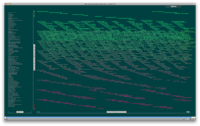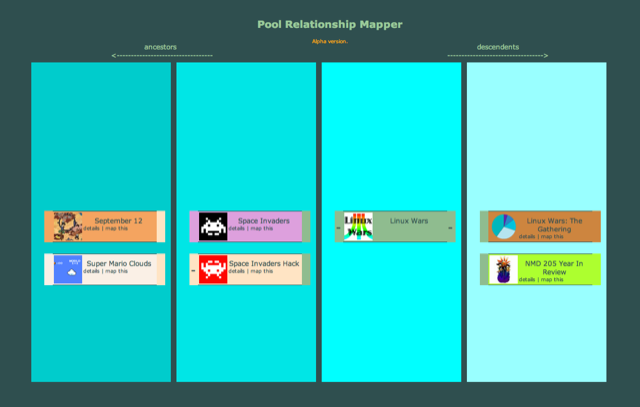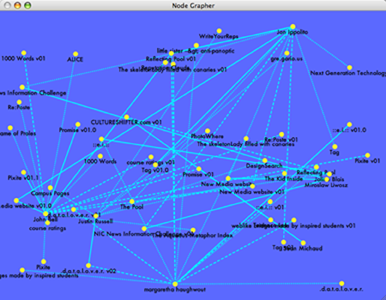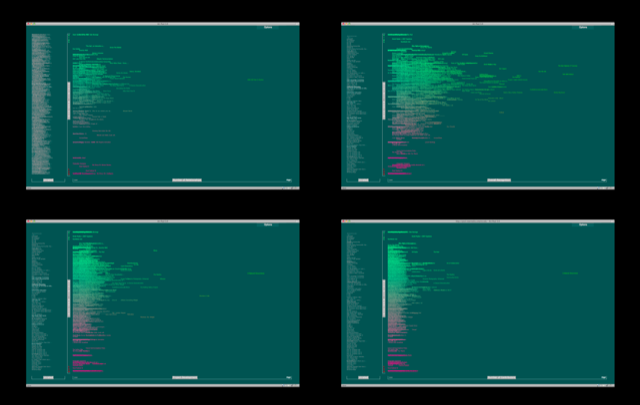 Analysis of the collaborative online environment The Pool suggests that inequalities in some creative networks may level out over time due to the long-term effects of user ratings.
Analysis of the collaborative online environment The Pool suggests that inequalities in some creative networks may level out over time due to the long-term effects of user ratings.
This is version 1.1; a synopsis of this paper (version 1.0) was originally presented at Arts | Humanities | Complex Networks, Leonardo satellite symposium, NetSci 2010, BarabásiLab -- Center for Complex Network Research, Northeastern University, Boston, on 10 May 2010.
It's a cliche that politics makes for strange bedfellows, but the coexistence of top-down and bottom-up processes on the Internet still catches many of us off guard. We've long ignored or tolerated the contradiction implied by leaders like Gandhi and Guevara championing the common peasant. Nonetheless, it seems to get further under our skin when we suspect that Linus Torvalds has too much influence over Linux, or Eli Pariser over MoveOn, or Jimmy Wales over Wikipedia.
Some examples clearly cross an ethical line, as when a WHOIS search on the anti net-neutrality domain HandsOffTheInternet.com revealed this "nationwide coalition of Internet users" to be a sock puppet of AT&T. Such attempts by entrenched interests to feign a grass-roots upswell, commonly called "astroturfing," unmask more than corporate executives posing as the common man. They also expose the envy that top-heavy dinosaurs feel for the agile flocks of new species that emerge from grass-roots.
To be sure, even some members of the agile new species claim that a certain degree of hierarchy is necessary to the smooth functioning of a network. As new media artist Michael Mandiberg argued on the New Media Curating mailing list in June 2008,
Hierarchy & Leadership *is* ultimately necessary when people are working together in a significant scale (more than two or three)....I see a number of large scale open source projects run out of the OpenLab, and ultimately it comes down to one or two project leaders, who have the vision, the mad skillz, and the enormous time commitment to *organize* the other collaborators. These roles *can* shift over time. This is true for software work and RL [real life] work.
I have also many times attempted to do the perfect-collaboration-where-everyone-has-the-same-responsibility-and-does-the-same-work-and-gets-the-same-credit. _it_doesn't_work_. someone always flakes out. someone one's skills are always more labor intensive, or more needed in each project. someone is always too bossy or controlling. nothing is perfect. utopia is the land that does not exist. that is just the way it goes....
There are lots of ways of doing it, but I do think that as much as they pretend pure openness, successful OS [open source] projects all have hierarchy.
But is hierarchy really the natural endpoint of collaborative networks? While leaders often emerge from collective efforts, not all of them mature into Napoleons, and indeed not all inequalities worsen with time. Sometimes the rich actually get poorer, as demonstrated by examples from natural and human networks, as well as The Pool, a social network designed specifically to foster peer-to-peer collaboration.
In his book Nexus: Small Worlds and the Groundbreaking Theory of Networks, Mark Buchanon describes two kinds of small-world networks. The original type, discovered by Duncan Watts and Steve Strogatz, is an acentric topology of random links. In a truly acentric network, no node is preferred and all have roughly the same number of connections. The second type, discovered by Albert Laszlo-Barabasi and Reka Albert, is a polycentric, "aristocratic" network. This aristocratic variant follows the network power law, whereby a few nodes have lots of links and the rest have only a few (the so-called "fat tail" distribution).
Both networks are small-world in the sense that it only takes a few jumps to get from one node to any other--on the order of the proverbial "six degrees of separation"--and both have been modeled via computer simulations. Many human-made and natural examples of small-world networks are the aristocratic, polycentric variety; examples include the routers on the Internet, pages on the Web, and molecular reactions in E. coli. The name "aristocratic" is somewhat misleading, however, because the aristocratic nodes are not "managers" in any hierarchic sense. To paraphrase George Orwell, all nodes are created equal, but some have more connections than others.
While Buchanon sometimes characterizes human networks in aristocratic terms, Nexus offers encouragement for the underdogs in physicist Luis Amaral's discovery that aristocratic networks often evolve into more egalitarian ones when pressured by real-world constraints. Network theorists often give the example of airline flight routes as a polycentric system, in that most flights pass through a dozen or so "hubs." Yet over the last few decades as runways back up and hubs like Atlanta or Chicago become clogged, smaller airports have emerged to take on more of the burden. Similarly, the number of connections among neurons in the worm C. elegans have evolved to become roughly equal, as have the number of electrical connections among elements in the US electrical grid, because the spatial requirements of each node admit only so many additional connections.
 In Permaculture this tendency for a network to become more egalitarian with time is called "catchment." As Joline Blais describes in her essay "Indigenous Domain: Pilgrims, Permaculture, and Perl," catchment is a natural process that starts out like capital, in that wealth accumulates unequally at first. The longer-term trajectory of catchment, however, is dramatically different from that of capitalism. Divots in the desert that accummulate rain and seeds will initially grow greener than the sand around them, just as startup founders have more capital than their employees. However, while the disparity between founders and rank and file will only grow wider as the company prospers, by contrast plants in the desert will eventually overgrow the gaps between them, to the point where there's no way to tell where the catchment began. Capital builds a pyramid in the desert, a monument designed to exalt the hierarch built on the labor of society's lower strata. Catchment weaves a network, a dense fabric of interconnected life with no clear winners and losers.
In Permaculture this tendency for a network to become more egalitarian with time is called "catchment." As Joline Blais describes in her essay "Indigenous Domain: Pilgrims, Permaculture, and Perl," catchment is a natural process that starts out like capital, in that wealth accumulates unequally at first. The longer-term trajectory of catchment, however, is dramatically different from that of capitalism. Divots in the desert that accummulate rain and seeds will initially grow greener than the sand around them, just as startup founders have more capital than their employees. However, while the disparity between founders and rank and file will only grow wider as the company prospers, by contrast plants in the desert will eventually overgrow the gaps between them, to the point where there's no way to tell where the catchment began. Capital builds a pyramid in the desert, a monument designed to exalt the hierarch built on the labor of society's lower strata. Catchment weaves a network, a dense fabric of interconnected life with no clear winners and losers.
Unlike in the desert, electrical grid, or worm brain, many of our Internet-mediated networks have no automatic scarcity to drive the equalization of nodes. That's one of the things we appreciate about them--but it can inadvertently lead to rich-get-richer systems. Fortunately, we can tweak the software governing these networks to encourage the evolution from aristocracy to equality.
 This balancing effect seems to be acting in The Pool, an online environment built by the University of Maine's Still Water lab to stimulates and tracks collaborations in art, text, and code. At any given time about 300 students in universities across the U.S. are active in The Pool, proposing ideas, building projects, and reviewing each other's progress. The Pool currently tracks 6000 reviews of over 2000 project versions; what's curious about those reviews is that there seems to be a mechanism at play, unintended by its creators, that keeps its most active projects from getting rated too highly.
This balancing effect seems to be acting in The Pool, an online environment built by the University of Maine's Still Water lab to stimulates and tracks collaborations in art, text, and code. At any given time about 300 students in universities across the U.S. are active in The Pool, proposing ideas, building projects, and reviewing each other's progress. The Pool currently tracks 6000 reviews of over 2000 project versions; what's curious about those reviews is that there seems to be a mechanism at play, unintended by its creators, that keeps its most active projects from getting rated too highly.
The Pool departs from a conventional social network in that the primary nodes are creative projects rather than people; Pool users themselves are indirectly connected to each other via their collaborations on or reviews of each other's projects. In fact, a node has several measures of connectedness, such as the number of contributors, the number of reviews, or the number of relationships to other nodes. That said, a node's success in The Pool is typically measured not by the number of connections but by the average approval bestowed by its reviewers.
 While online social networks like Facebook benefit from the structure of small-world networks, few of their interfaces are designed to make their users conscious of this structure. Users of The Pool, by contrast, navigate a graphical interface that portrays at any given time the emergent structure of the community. The Pool's graphical interface makes it relatively easy to visualize relationships among creative people and their works, such as how collaborators are related ("who collaborates with my collaborators?") and how creative works inspire new works ("who has remixed my remix?"). These social connections appear roughly to follow the power law typical of aristocratic networks.
While online social networks like Facebook benefit from the structure of small-world networks, few of their interfaces are designed to make their users conscious of this structure. Users of The Pool, by contrast, navigate a graphical interface that portrays at any given time the emergent structure of the community. The Pool's graphical interface makes it relatively easy to visualize relationships among creative people and their works, such as how collaborators are related ("who collaborates with my collaborators?") and how creative works inspire new works ("who has remixed my remix?"). These social connections appear roughly to follow the power law typical of aristocratic networks.
TOP: A view of the "family tree" of a single project in The Pool, showing its relationship to predecessors and to projects that it influenced.
BELOW: A slice of The Pool's social network, as seen in the graph of a single user's collaborators, plus the collaborators of her collaborators.
 Adding the parameter of approval to the analysis, however, complicates the usual picture of a "rich-get-richer" system. Unlike pedagogical software centered on the teacher, success in The Pool is an emergent property of feedback from one's peers, and can be gauged by the average rating given a project. Curiously, whether graphed against the number of relationships, reviews, versions, or contributors, approval appears to follow a log-normal distribution with a mode approximately equal to 75% of the maximum approval.
Adding the parameter of approval to the analysis, however, complicates the usual picture of a "rich-get-richer" system. Unlike pedagogical software centered on the teacher, success in The Pool is an emergent property of feedback from one's peers, and can be gauged by the average rating given a project. Curiously, whether graphed against the number of relationships, reviews, versions, or contributors, approval appears to follow a log-normal distribution with a mode approximately equal to 75% of the maximum approval.
There are several possible explanations for this. One is that reviewers expect more from more mature projects. Another is that projects with only a few very high ratings may reflect accidental sample bias, as when a Trekkie gives a remix of Star Trek episodes a 10 out of 10. Or the increasing incidence of bad reviews could be due to rivals sniping at a frontrunner.
Whatever the cause, the effect is that frontrunners in The Pool feel a kind of critical resistance that limits their ability to dominate the high scores. The situation is a bit like bike racing: Lance Armstrong may be the best in the pack, but he also feels more drag than those drafting behind him--a negative feedback loop that prompts racers to rotate leaders rather than install the best one permanently in first place.
ABOVE: As measured against four different measures of maturity (horizontal axes), Pool projects trend toward a 75% approval rating (vertical axes).
Ethics aside, there are good reasons to design networks resistant to pyramidization. Mandiberg is right: people who take on more responsibility frequently advance to become leaders. However, such "natural" leaders also become vulnerable points in the system, whether the system is a hierarchy or network. For Linus Torvalds to denounce Linux would devastate the morale of its community, just as Steve Jobs' departure from Apple is sure to tank its stock share. Any network that depends too strongly on one or a handful of nodes is in danger of collapsing when they do.
Fortunately, some systems naturally flatten hierarchies as they mature. The evolution of reputation in The Pool suggests that recognition, project development, and collectivism are correlated with approval, but as projects mature and garner more feedback their approval rating approaches a limiting value. For network theorists, this argues that the number of connections alone, independent of a more subjective measure of quality, may not be an adequate metric for analyzing social networks, at least those focused on creative activity such as art and innovation. For political theorists, it suggests that spiraling inequalities may be less an inevitable consequence of political systems than evidence of a design flaw in their constitution.